Transverse & Longitudinal Waves | Physics for Grade 10 PDF Download
| Table of contents |

|
| Introduction to Transverse Waves |

|
| Transverse Waves |

|
| Longitudinal Waves |

|
| Transverse v Longitudinal Waves |

|
Introduction to Transverse Waves
- Waves are repeated vibrations that transfer energy
- Energy is transferred by parts of the wave knocking nearby parts
- This is similar to the effect of people knocking into one another in a crowd, or a "Mexican Wave" at football matches
- Waves can exist as one of two types:
- Transverse
- Longitudinal
Transverse Waves
- Transverse waves are defined as:
Waves where the points along its length vibrate at 90 degrees to the direction of energy transfer - For a transverse wave:
- The energy transfer is in the same direction as the wave motion
- They transfer energy, but not the particles of the medium
- Transverse waves can move in a liquid or solid, but not a gas
- Some transverse waves (electromagnetic waves) can move in a vacuum
- The point on the wave that is:
- The highest above the rest position is called the peak, or crest
- The lowest below the rest position is called the trough
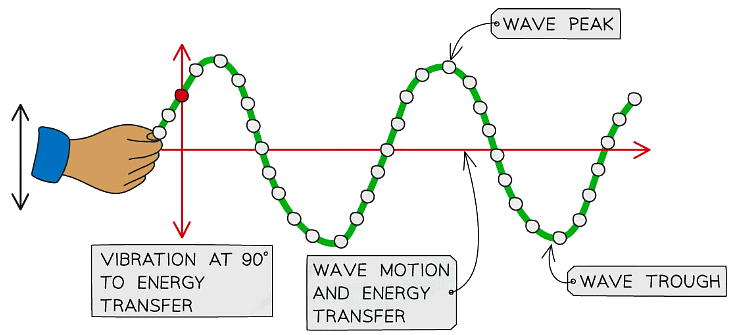 Transverse waves can be seen in a rope when it is moved quickly up and down
Transverse waves can be seen in a rope when it is moved quickly up and down
- Examples of transverse waves are:
- Ripples on the surface of water
- Vibrations in a guitar string
- S-waves (a type of seismic wave)
- Electromagnetic waves (such as radio, light, X-rays etc)
Representing Transverse Waves
- Transverse waves are drawn as a single continuous line, usually with a central line showing the undisturbed position
- The curves are drawn so that they are perpendicular to the direction of energy transfer
- These represent the peaks and troughs
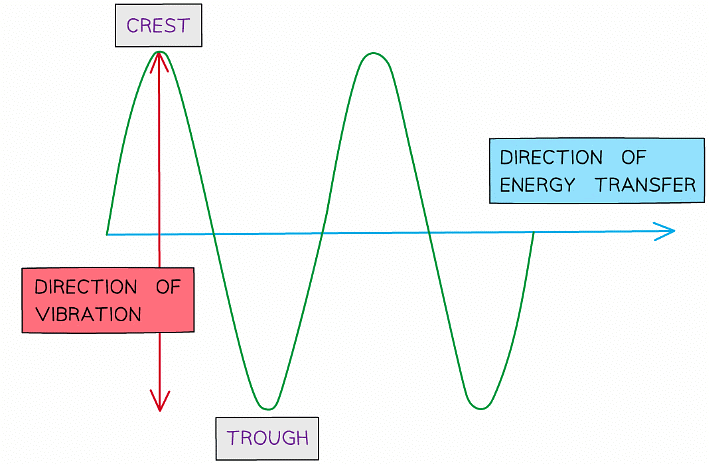 Transverse waves are represented as a continuous solid line
Transverse waves are represented as a continuous solid line
Longitudinal Waves
- Longitudinal waves are defined as:
Waves where the points along its length vibrate parallel to the direction of energy transfer - For a longitudinal wave:
- The energy transfer is in the same direction as the wave motion
- They transfer energy, but not the particles of the medium
- They can move in solids, liquids and gases
- They can not move in a vacuum (since there are no particles)
- The key features of a longitudinal wave are where the points are:
- Close together, called compressions
- Spaced apart, called rarefactions
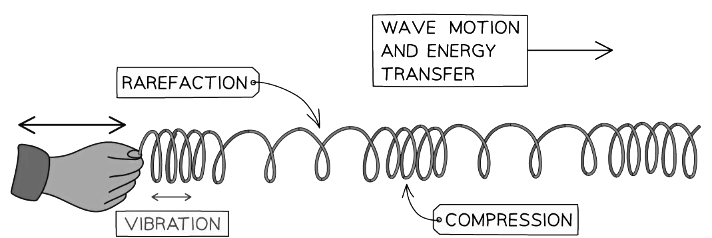 Longitudinal waves can be seen in a slinky spring when it is moved quickly backwards and forwards
Longitudinal waves can be seen in a slinky spring when it is moved quickly backwards and forwards
- Examples of longitudinal waves are:
- Sound waves
- P-waves (a type of seismic wave)
- Pressure waves caused by repeated movements in a liquid or gas
Representing Longitudinal Waves
- Longitudinal waves are usually drawn as several lines to show that the wave is moving parallel to the direction of energy transfer
- Drawing the lines closer together represents the compressions
- Drawing the lines further apart represents the rarefactions
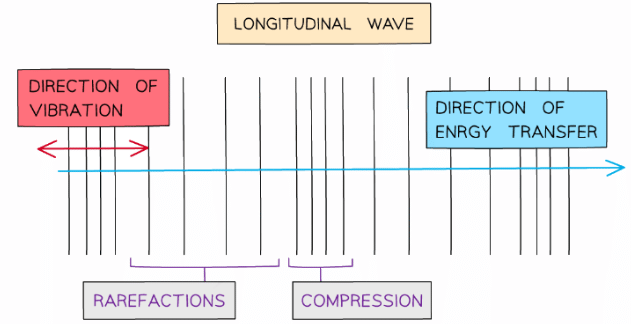 Longitudinal waves are represented as sets of lines with rarefactions and compressions
Longitudinal waves are represented as sets of lines with rarefactions and compressions
Transverse v Longitudinal Waves
- Their different motions can be shown on ropes (transverse) and springs (longitudinal)
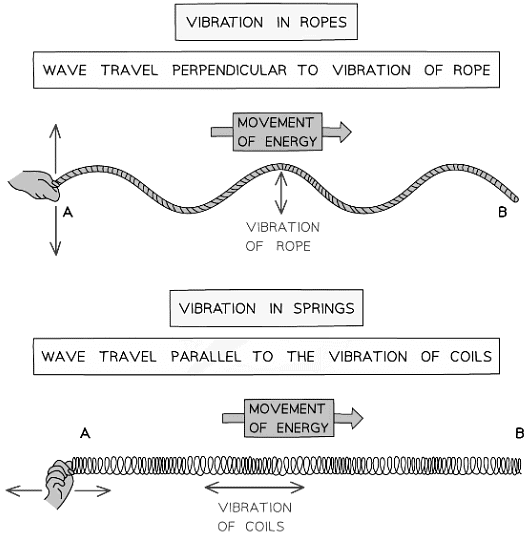 Waves can be shown through vibrations in ropes or springs
Waves can be shown through vibrations in ropes or springs
- The different properties of transverse and longitudinal waves are shown in the table:
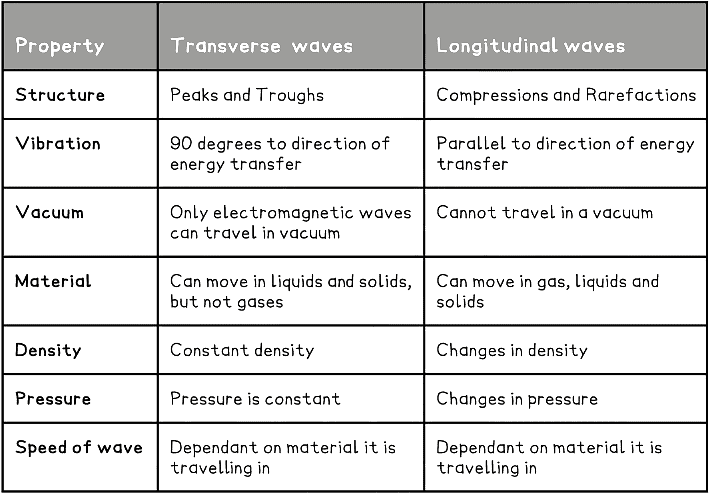 Transverse Waves v Longitudinal Waves Table
Transverse Waves v Longitudinal Waves Table
Wavefronts
- Both transverse and longitudinal waves can be represented as wavefronts
- This is where the waves are viewed from above
- For a transverse wave:
- One line represents either a peak or a trough
- For a longitudinal wave:
- One line represents either a compression or a rarefaction
- The arrow shows the direction the wave is moving and is sometimes called a ray
- The space between the lines represents the wavelength
- When the lines are close together, this is a wave with a short wavelength
- When the lines are far apart, this is a wave with a long wavelength
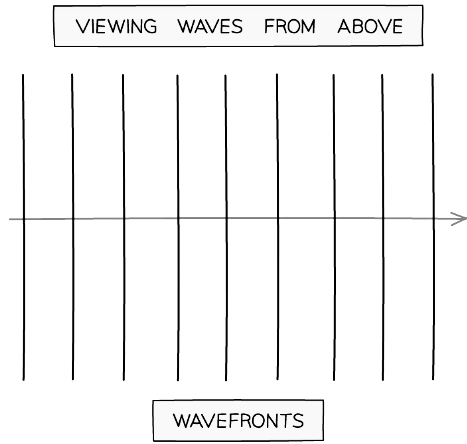 Solved Example
Solved Example
Both transverse and longitudinal waves can travel through water. The diagram below shows a toy duck bobbing up and down on top of the surface of some water. Explain how the toy duck demonstrates that waves do not transfer matter.
Explain how the toy duck demonstrates that waves do not transfer matter.
Step 1: Identify the type of wave
- The type of wave on the surface of a body of water is a transverse wave
- This is because the duck is moving perpendicular to the direction of the wave
Step 2: Describe the motion of the toy duck
- The plastic duck moves up and down but does not travel with the wave
Step 3: Explain how this motion demonstrates that waves do not transfer matter
- Both transverse and longitudinal waves transfer energy, but not the particles of the medium
- This means when a wave travels between two points, no matter actually travels with it, the points on the wave just vibrate back and forth about fixed positions
- Objects floating on the water simply bob up and down when waves pass under them, demonstrating that there is no movement of matter in the direction of the wave, only energy
Exam Tip
Exam questions may ask you to describe waves and this is most easily done by drawing a diagram of the wave and then describing the parts of the wave - a good, clearly labelled diagram can earn you full marks!
Make sure you know the difference between the wave front diagram and the longitudinal wave diagram, do not confuse the two!
|
122 videos|150 docs|40 tests
|




















